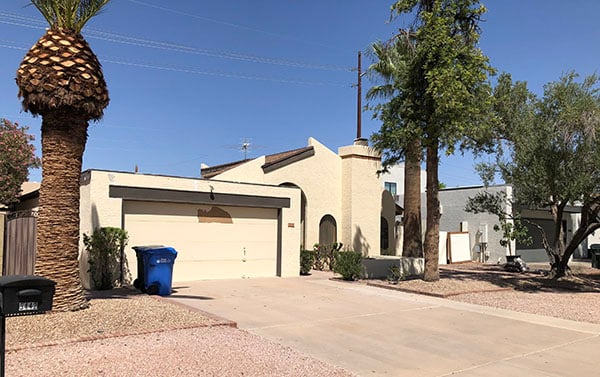How To Calculate Real Estate Return on Investment + 2024 Averages


In 2024, the average real estate return on rental property is 10.6% while the average commercial real estate ROI is 9.5%.
Jump to 5-year historical average real estate returns
Pew Research Center studies indicate that individual real estate investors account for almost 73% of single-unit rental properties in the United States. If you want to be included in this 73% and start earning passive income, understanding your potential return on investment (or ROI) on a property is one of the first steps to getting there.
For a lot of people, real estate investing involves a direct private money loan – or a loan secured by a private company or lender like Revolution Realty Capital. Having the finances to support your real estate investments is critical for earning a positive ROI.
In this post, we’ll explain how to calculate real estate return on investment plus give you common ROI formulas for real estate and the average real estate returns for 2024.
Table of Contents:
- What Is ROI in Real Estate?
- How To Calculate ROI on Real Estate Investments
- Additional Real Estate Profitability Metrics
- Average ROI on Real Estate
- Real Estate vs. Stocks Historical Return
What Is ROI in Real Estate?
Real estate return on investment (ROI) is a metric used to calculate profits, and ultimately, measure whether a property is worth investing in. ROI is determined by a number of factors – including purchase price, closing costs, sales price, and more. This metric helps investors predict the profit margins on real estate investment opportunities, be it from flipping or renting out properties.
The real estate return on investment is typically the reason people get involved in real estate in the first place. However, buying investment property shouldn’t be taken lightly. It’s important for investors of all experience levels to calculate the ROI for a concrete, birds-eye-view of the profitability of a prospective property.
So, what is ROI in real estate in your area and how can you calculate it?
How To Calculate ROI on Real Estate Investments
Generally speaking, to calculate return on real estate investment, you’ll want to divide your equity in an investment property by the costs associated with it. There are two common return on investment formulas for real estate: the cost method and the out-of-pocket method.
After you understand how to calculate real estate return on investment, it’s crucial that you use the same calculation methods for each property. This will give you a more accurate depiction of which investment property will be most profitable.
Real Estate ROI Formula For Cash Transactions
For cash transactions (i.e. there’s no lender or financing involved), you’ll use the cost method to calculate ROI either before or after buying investment property. The cost method formula calculates real estate return on investment by dividing a property’s equity by its total costs.
Cost Method Formula: Property’s Equity / Total Costs = ROI
Let’s say a property was purchased for $125,000. After investing in repairs for a total of $75,000, the property is now valued at $250,000. This means the real estate investor’s equity position in the property is $50,000 (property value of $250,000 less the $200,000 invested in the property).
Let’s apply this equity position in the cost method real estate ROI formula:
Cost Method: $50,000 / $200,000 = 0.25 or 25% ROI
ROI Formula For Financed Transactions
While the cost method is a sufficient ROI formula in real estate for cash transactions, the out-of-pocket method leverages loans and financing. This then increases equity and therefore ROI, and is generally preferred by real estate investors.
Using the same example above, let’s say an investment property was bought for the same price of $125,000. However, the investor opted to finance the property with a loan and made a down payment of only $30,000. This makes the out-of-pocket expense only $30,000 plus $75,000 in repairs, totaling $105,000. If the property value remains at $250,000, the equity position would now be $145,000.
Let’s apply this equity position in the out-of-pocket real estate ROI formula:
Out-of-pocket Method: $145,000 / $250,000 = 0.58 or 58% ROI
Because financing often results in a higher ROI, many investors pursue this route. However, the lender you choose to partner with can also make a positive or negative impact on your returns. With closing periods 10 days or less and some of the most competitive rates in the industry, partnering with Revolution Realty Capital can help you maximize your ROI.
Lorem ispum dolor sit umit

Lorem ipsum dolor sit amet, consectetur adipiscing elit. Proin interdum dolor a ullamcorper molestie. Vivamus in justo velit. Aliquam vehicula massa et venenatis placerat.
Subtitle in the post
Adipiscing elit. Proin interdum dolor a ullamcorper molestie. Vivamus in justo velit. Aliquam vehicula massa et venenatis placerat. In hac habitasse platea dictumst. Maecenas scelerisque ipsum et mauris aliquam, eget rhoncus enim facilisis. Praesent tincidunt vehicula ante, sed tempus libero vulputate at. Proin sed erat neque. Vivamus faucibus magna at facilisis suscipit.
- Taesent tincidunt vehicula ante, sed tempus libero vulputate.
- Lorem ipsum dolor sit amet, consectetur adipiscing elit.
- Taesent tincidunt vehicula ante, sed tempus libero vulputate.
- Lorem ipsum dolor sit amet, consectetur adipiscing elit.

Lorem ipsum dolor sit amet, consectetur adipiscing elit. Proin interdum dolor a ullamcorper molestie. Vivamus in justo velit. Aliquam vehicula massa et venenatis placerat.

Lorem ipsum dolor sit amet, consectetur adipiscing elit. Proin interdum dolor a ullamcorper molestie. Vivamus in justo velit. Aliquam vehicula massa et venenatis placerat.
Subtitle in the post
Adipiscing elit. Proin interdum dolor a ullamcorper molestie. Vivamus in justo velit. Aliquam vehicula massa et venenatis placerat. In hac habitasse platea dictumst. Maecenas scelerisque ipsum et mauris aliquam, eget rhoncus enim facilisis. Praesent tincidunt vehicula ante, sed tempus libero vulputate at. Proin sed erat neque. Vivamus faucibus magna at facilisis suscipit.
Taesent tincidunt
vehicula ante, sed tempus libero vulputate.
Taesent tincidunt
vehicula ante, sed tempus libero vulputate.
Taesent tincidunt
vehicula ante, sed tempus libero vulputate.
Taesent tincidunt
vehicula ante, sed tempus libero vulputate.

- Taesent tincidunt vehicula ante, sed tempus libero vulputate.
- Lorem ipsum dolor sit amet, consectetur adipiscing elit.
- Lorem ipsum dolor sit amet, consectetur adipiscing elit.
- Taesent tincidunt vehicula ante, sed tempus libero vulputate.

Proin interdum dolor a ullamcorper molestie. Vivamus in justo velit. Aliquam vehicula massa et venenatis placerat. In hac habitasse platea dictumst. Maecenas scelerisque ipsum et mauris aliquam, eget rhoncus enim facilisis. Praesent tincidunt vehicula ante, sed tempus libero vulputate at. Proin sed erat neque.”

Proin interdum dolor a ullamcorper molestie. Vivamus in justo velit. Aliquam vehicula massa et venenatis placerat. In hac habitasse platea dictumst. Maecenas scelerisque ipsum et mauris aliquam, eget rhoncus enim facilisis. Praesent tincidunt vehicula ante, sed tempus libero vulputate at. Proin sed erat neque.”
Daniel William
Co-Foundet Acme Corp
Additional Real Estate Profitability Metrics
The cost and out-of-pocket methods can paint a general picture of how beneficial a rental or investment property will be. However, if you want more detailed metrics that pertain to different aspects of a property, use the formulas below to enhance your ROI projections.
Capitalization Rate (Cap Rate)
Cap rate, or capitalization rate, is the third most popular way to determine real estate return on investment. Cap rate estimates rental property profitability in total – regardless of the financing method used. When comparing investment properties, it’s common to use cap rate for a straightforward glance at ROI.
Capitalization Rate Formula: (NOI / Property Value) x 100% = ROI
For example, an investor is looking to buy a property to rent out that’s valued at $300,000. After subtracting operating expenses from total revenue, the net operating income (NOI) for said property is $30,000.
Capitalization Rate: ($30,000 / $300,000) x 100% = 10% ROI
Cash on Cash Returns (CoC)
Cash on cash returns (CoC) accounts for the total amount of invested cash into the real estate return on investment formula. In relation to the standard ROI formula mentioned above, CoC returns replace expenses and rental income with annual pre-tax cash flow.
Cash on Cash Return: (Annual Before Tax Cash-Flow / Total Invested) = ROI
For example, a $500,000 single-family home was purchased with $200,000 of invested cash and generates $50,000 in pre-tax cash flow each year, resulting in a 10% real estate return on investment.
Cash on Cash Return: ($50,000 / $500,000) x 100% = 10% ROI
Gross Rent Multiplier (GRM)
The gross rent multiplier is another method for measuring the profitability of an income producing property. The GRM of a property expresses how it compares in rental income compared to properties similar in value. Note here that GRM is most useful when comparing two or more properties.
Gross Rent Multiplier: (Property Value / Gross Rental Income) = ROI
Say, for instance, an investor is looking at buying investment property in two different neighborhoods. In the first neighborhood, there’s a property for sale valued at $300,000 and collects $50,000 in rent annually. In the second neighborhood, a similar property is valued at $250,000, and collects $45,000 in rent per year. Which property, then, will be most profitable?
Gross Rent Multiplier:
- Property 1: ($300,000 / $50,000) = 6
- Property 2: ($250,000 / $45,000) = 5.5
The lower the GRM, the higher your potential profits. In this instance, the property in the second neighborhood would give you a higher real estate return on investment based solely on rental income.
Average ROI on Real Estate
The average annual return over the past two decades from residential and commercial real estate is approximately 10%. The S&P 500 Real Estate Index measures national average real estate return on investment, and includes a number of real estate investments like single-family homes, apartments, and commercial buildings – to name a few.
Real estate return on investment depends on the kind of property being purchased. See the difference between the average rental property return against the average real estate return below:
Average rental property return: 10.6%
Average commercial real estate ROI: 9.5%
Many investors aim to match or exceed these average return rates when buying investment property.
Real Estate vs. Stocks Historical Returns
Investing in real estate doesn’t necessarily mean purchasing a physical property. Real estate investment trusts (REITs) that trade like stocks can provide investors with a further diversified portfolio. The chart below compares real estate vs. stocks historical returns via the Vanguard’s Real Estate ETF and SPDR® S&P 500 ETF Trust.
| Historical Real Estate Returns | Historical Stock Returns | |
|---|---|---|
| 2021 | 28.59% |
40.38% |
| 2020 | 18.25% |
-4.72% |
| 2019 | 31.29% |
28.91% |
| 2018 | -4.45% |
-5.95% |
| 2017 | 21.69% |
4.95% |
| 2016 | 11.80% |
8.53% |
Real estate vs. stocks returns is the million-dollar debate that investors are consistently mulling over. Ultimately, choosing between the two will depend on your risk tolerance and personal preference.
Knowing exactly how to calculate real estate return on investment is no simple feat. There are many factors involved in becoming a successful investor with strong monthly cash flow in the real estate market. If you’re new to investing, the best thing you can do is find a real estate partner or mentor that can help you develop the skills and knowledge to be successful.
If you’re ready to get started on your next project, contact us today and benefit from our 40+ years of experience in the industry.

Lorem ipsum dolor sit amet, consectetur adipiscing elit. Proin interdum dolor a ullamcorper molestie. Vivamus in justo velit. Aliquam vehicula massa et venenatis placerat.



